All right sports fans, get ready for a big photo dump (22). Unlike the 3D printing phase, the construction phase produces a lot of WIP photography with lots of various things going on. I was concentrating on finishing up the pan deck to get it ready for paint, and was still fussing with the gun girder. First let's tackle that.
I found out why the trunnion caps weren't aligning properly. After checking my master SketchUp drawing I found out that I had them on backwards. When I turned them around they fit fine. I also needed to check how the guns were fitting since the position of this girder on the kit base was further forward than the last girder I printed. Glad I checked. The new position was pushing the guns forward by about 1/8" and they were jamming in the kit opening. I didn't want to move the girder back since everything else about the position was perfect including the ofc's booth fit. To solve this problem I made some relief cuts in the gun manlet and the guns fit fine.
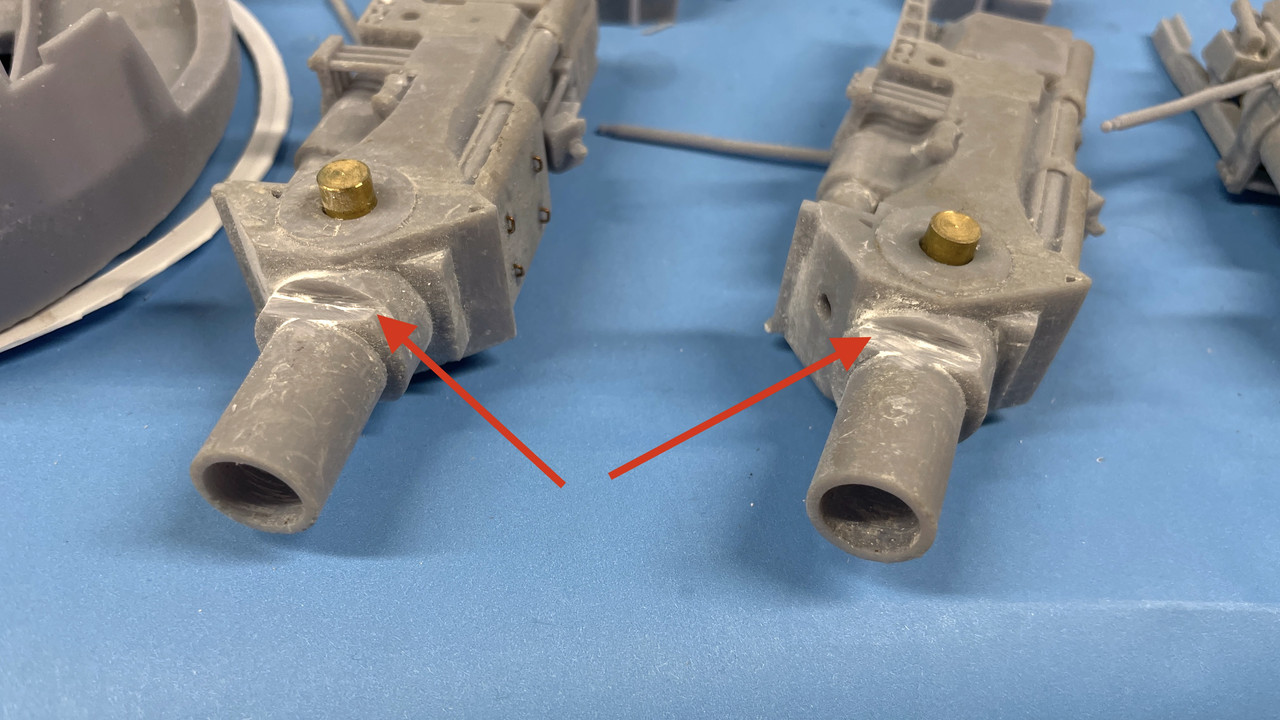
I then checked them with the kit's plastic bloomers and everything still worked including how the metal barrels engaged with the gun slide. Whew! Dodged that bullet. All of this mayhem is completely invisible in the finished model.
I then spent a lot of time fitting the gun rear compartments and the powder hoist operator's booths. The reason for all this fussing was the addition of the kit turret floor piece. I did not have that part as part of the design phase. It was just too hard for me to figure out what was what with it and I fully expected to do a lot of "field mods" to get it all to work. My expectations were correct.
The first problem was relieving the bottoms of the compartment prints so they would drop down and back to the correct final position. This was a trial and error affair. I did the cutting with the Dremel Flexishaft and a diamond coated cutting wheel. This job creates a huge amount of UV resin dust and I wore my dust mask so I wouldn't kill myself.
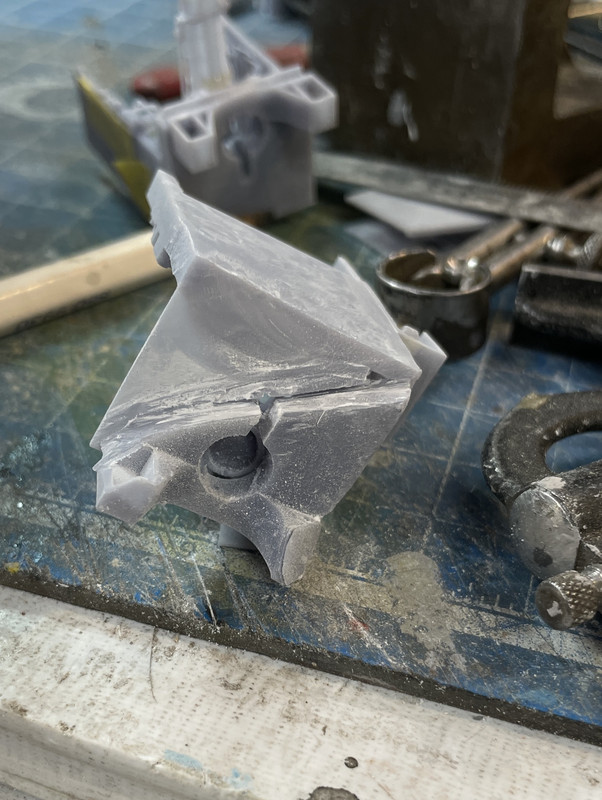
I also kind of knew from the start that my design of the powder hoist operators booths was going to cause a problem since in the rear ship, they share a common wall in the double hoist area as the powder trunks do. I produced them with two side was each. This is what it looked like when those two walls were trying to occupy the same space. Physics won't allow this.
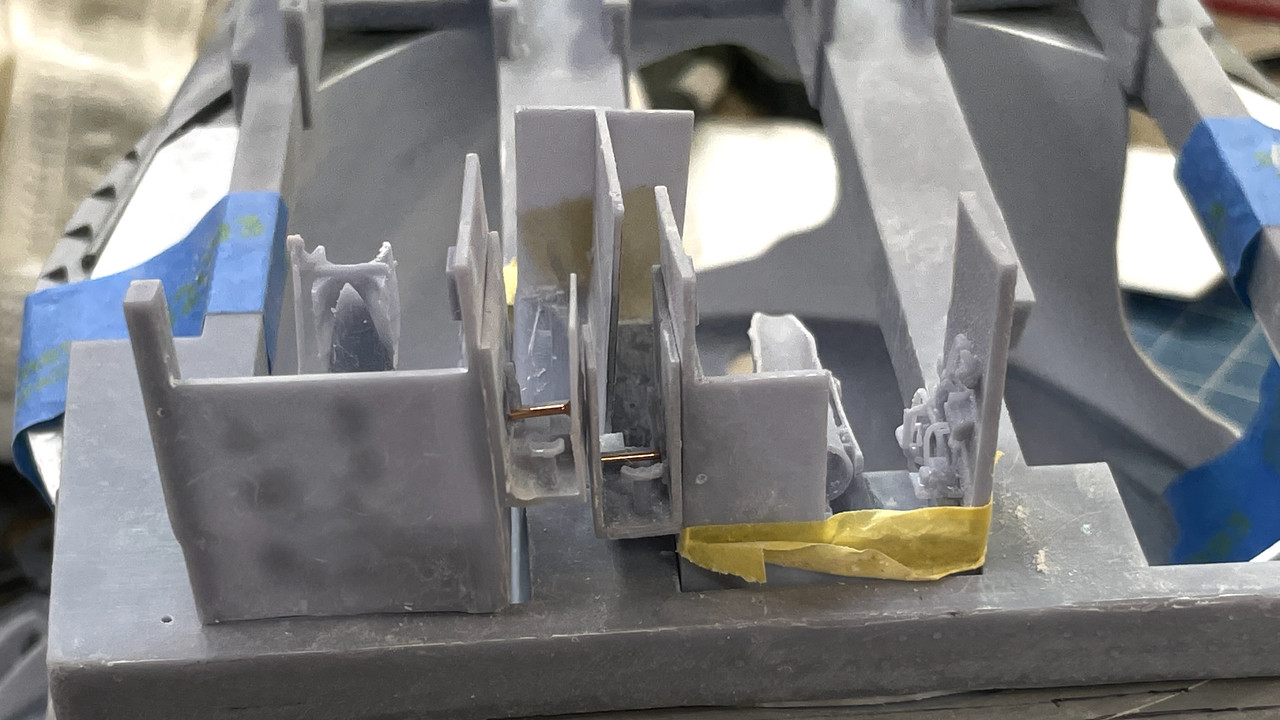
I had to surgically remove on of the walls. I also had to do major surgery on the edges that mated with the powder trunks themselves. Again, I new as I was drawing all this that I had absolutely no idea just how all these pieces were going to interact until I had the physical parts. After removing the wall, they do work together better. I CA's each respective hoist booth their gun compartments since the little observation window openings had to align for the booth to be at the proper height. I'm not worried about the open space beneath since the rear bulkhead butts up directly to these parts.
The other two guns powder carts will be down at the powder flat.

The right gun is going to have the powder door open with the cart in the upper position. It was especially trying to get the cart, the trunk and the rest of it to all work together. This is how it ended up. Again, the alcove part back wall with conceal that opening you see showing the cart's flank.

The last gun girder task was putting the thin styrene veneer on the rear compartment to act as the turret base plate. I made a paper template and then transferred this to the 0.020" styrene using the same PSA technique I used before. I will be using this technique a few times before the job is done.
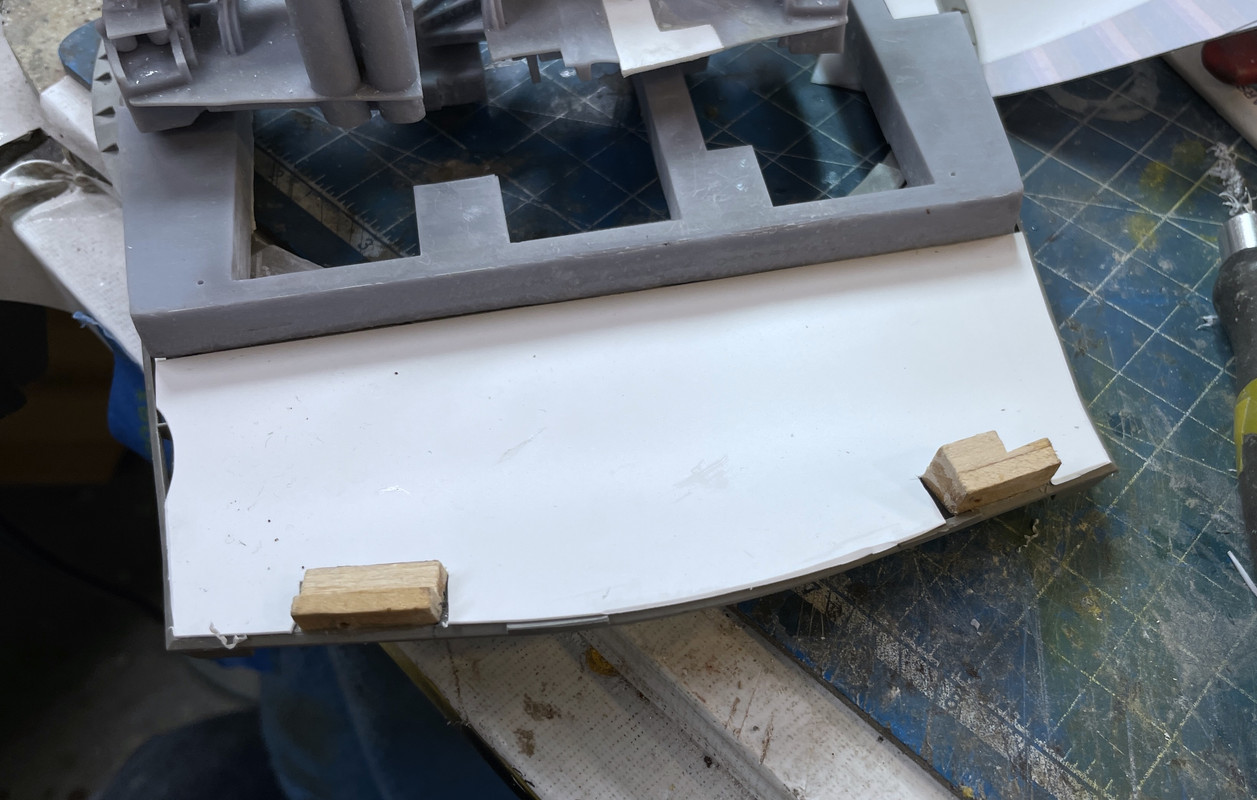
I test fit the rear compartment print to make sure that small lift the floor gave didn't cause any problems. it did not. This floor will have the non-slip flooring in the walkway like the prototype does.

I believe I can paint the gun girders now.
I got bacl to work on the pan deck. I had made a paper template of the transverse bulkhead that runs athwartship just behing the training machinery. I pasted the paper template onto a heavier strathmore stock and started doing the final fitting. I don't know why, but I found it necessary to make relief cuts in this bulkhead in SU. The guns were impacting it. I don't know the actual dimension of this bulkhead in the real ship. Since so many of my measurements are estimates I could have some stacking errors that crept in with the guns themselves. Just because they look great doesn't mean they're exactly scaled.
I added some height to my original drawing so it matched the height of the pan deck's walls. I then glued the strathmore template onto the 0.040" styrene.
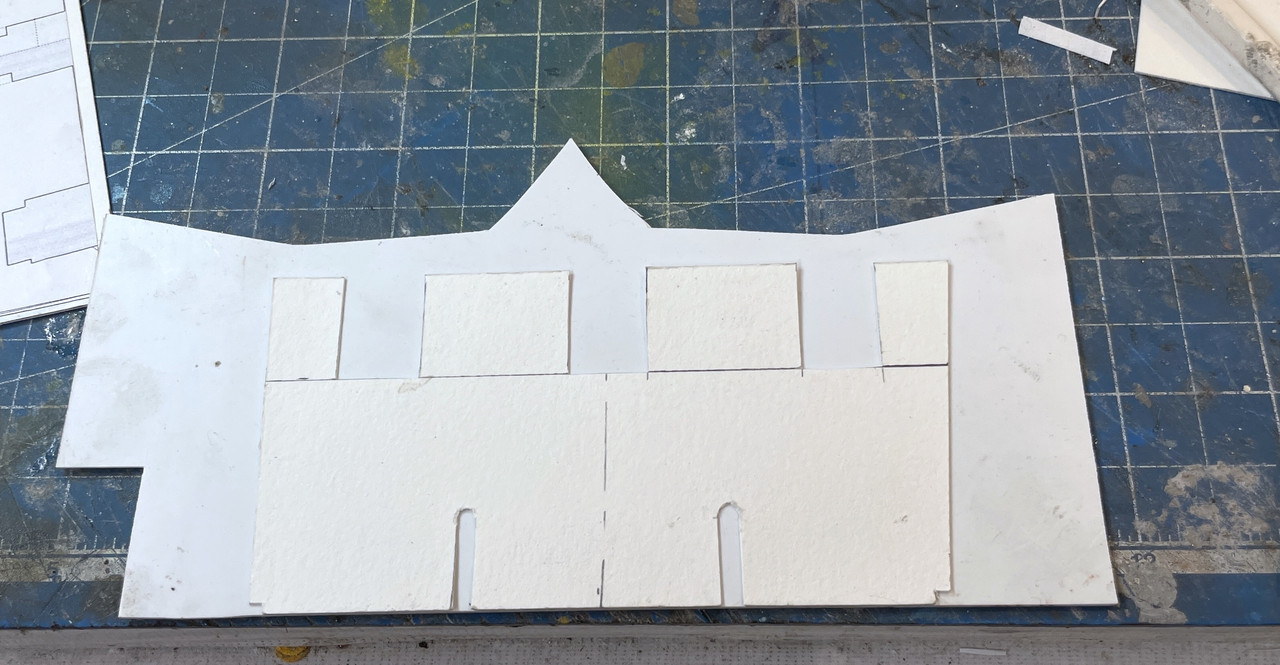
I had to keep adjusting the width and positioning to get it just right. I went back and measured my full-size SU drawing to capture the distance from the front of the shell to the bulkhead and then divided by 72 to get the actual number. My positioning was very close.
Another critical dimension was the positioning of the slots that the B-end hydraulics drive shaft that must align to the holes in the gear heads. It took a bit of fiddling to get this one right.
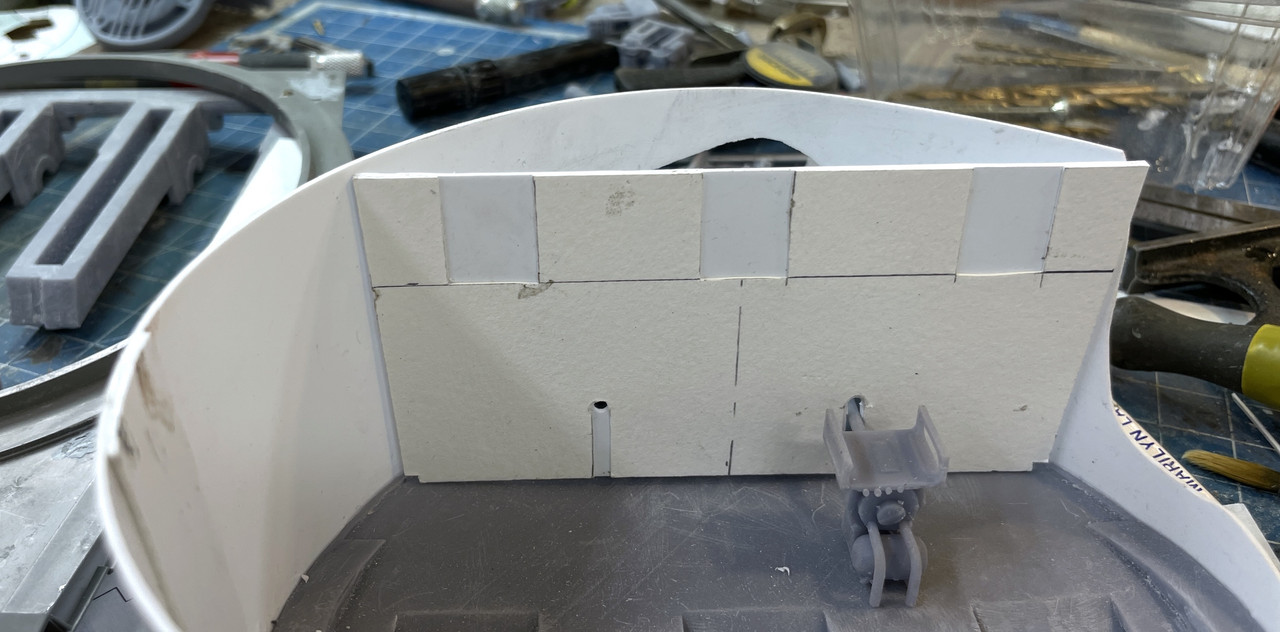
I used a square to hold it in position while I started with solvent cement to tack it in place.
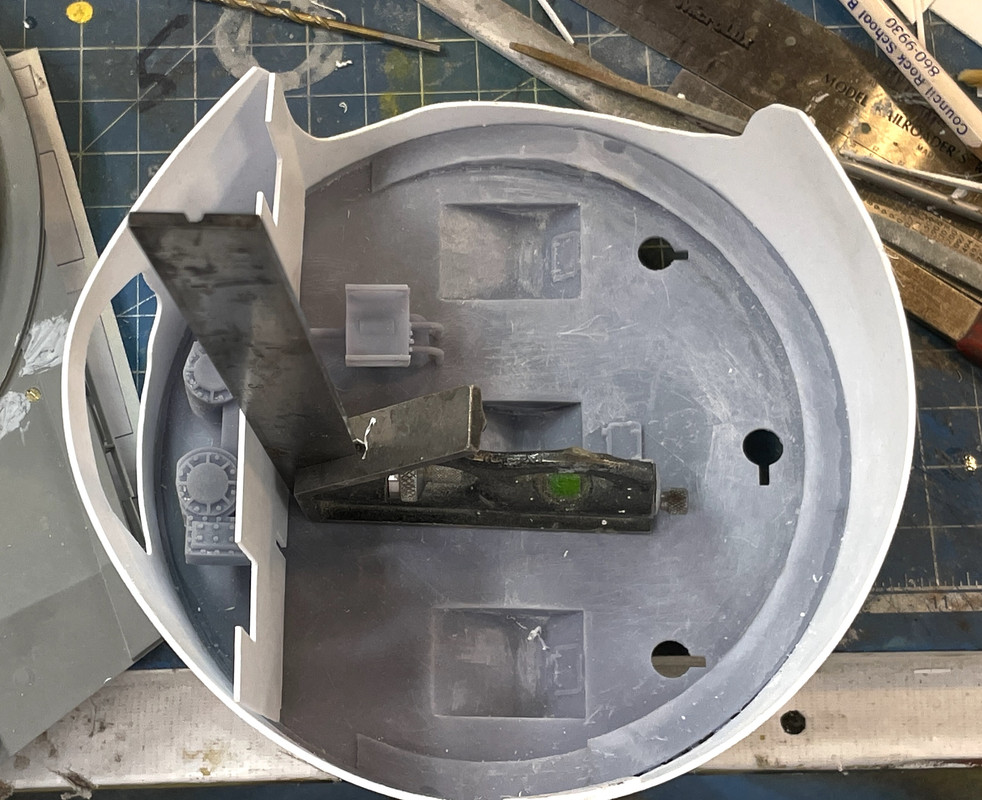
After the solvent cement set a bit, I went back and sealed all the edges with thick CA and accelerator. I will attach the B-ends AFTER all the pan deck is painted.
With the front bulkhead done, I crafted the center bulkhead that lies above and between the two gear heads. I had to notch this out just like the tranverse bulkhead to clear the gun, especially when they elevate and all the recoil mechanism on the bottom swings down. I'm only elevating the left gun, but the bulkheads have to look like the others could too.
This piece also stabilizes the flimsy area in front as a result of all the cutaway work. Again, started with Strathmore, then transferred to styrene when it was right. This shows the Strathmore.
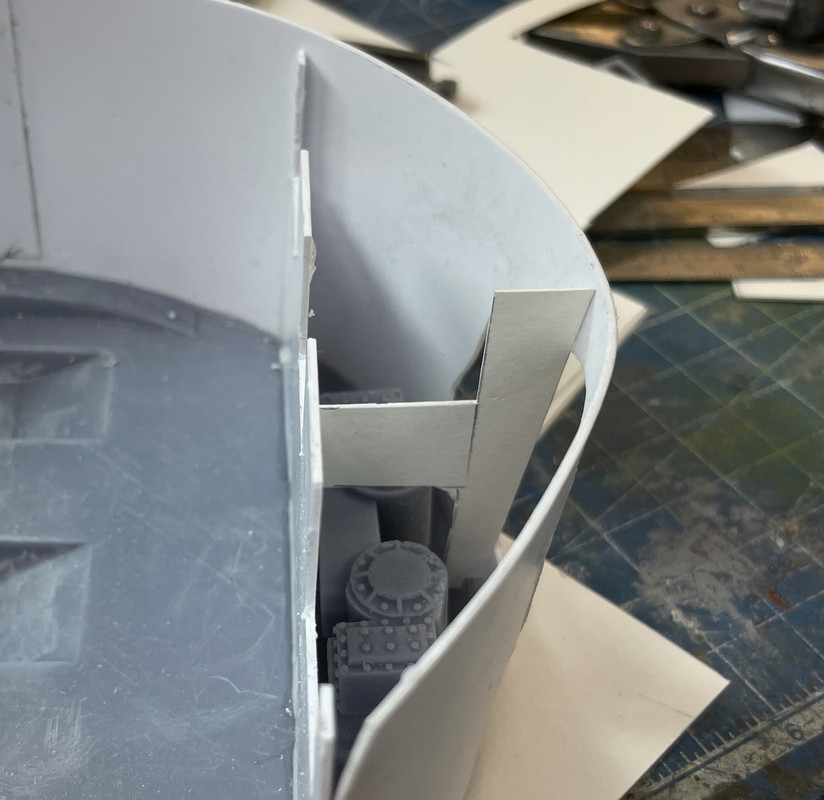
When the fit was right, I made the real one. In this case, I radiused both cut outs. I then added some 0.020" X .125" styrene strip to act as the typical welded webbing on all the perforations in all the bulkheads throughout the entire ship. This was fun, good old, old school scratch-building.
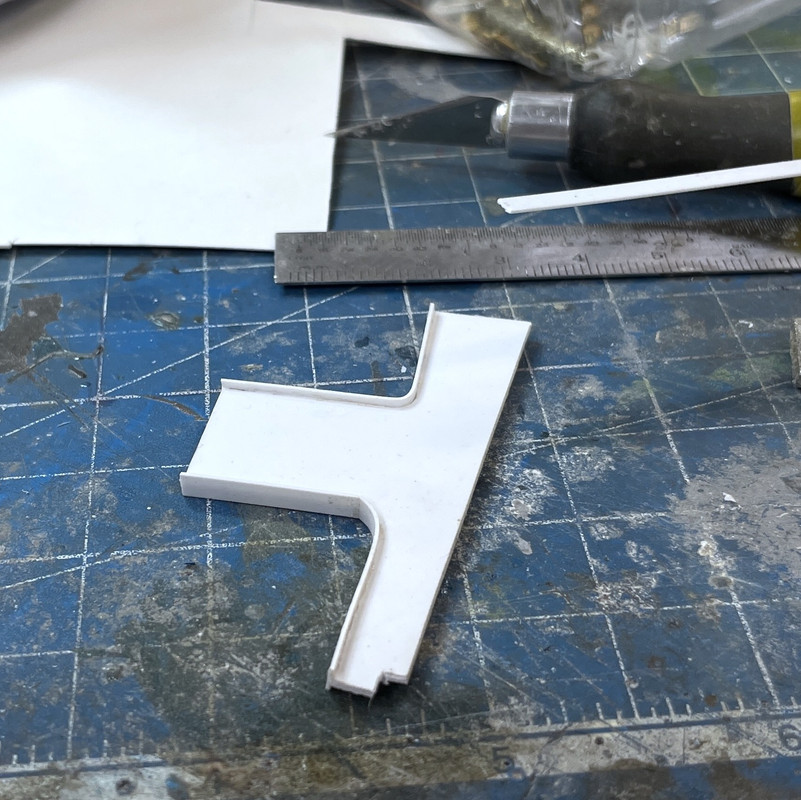
I did a final test fit, and liked it.
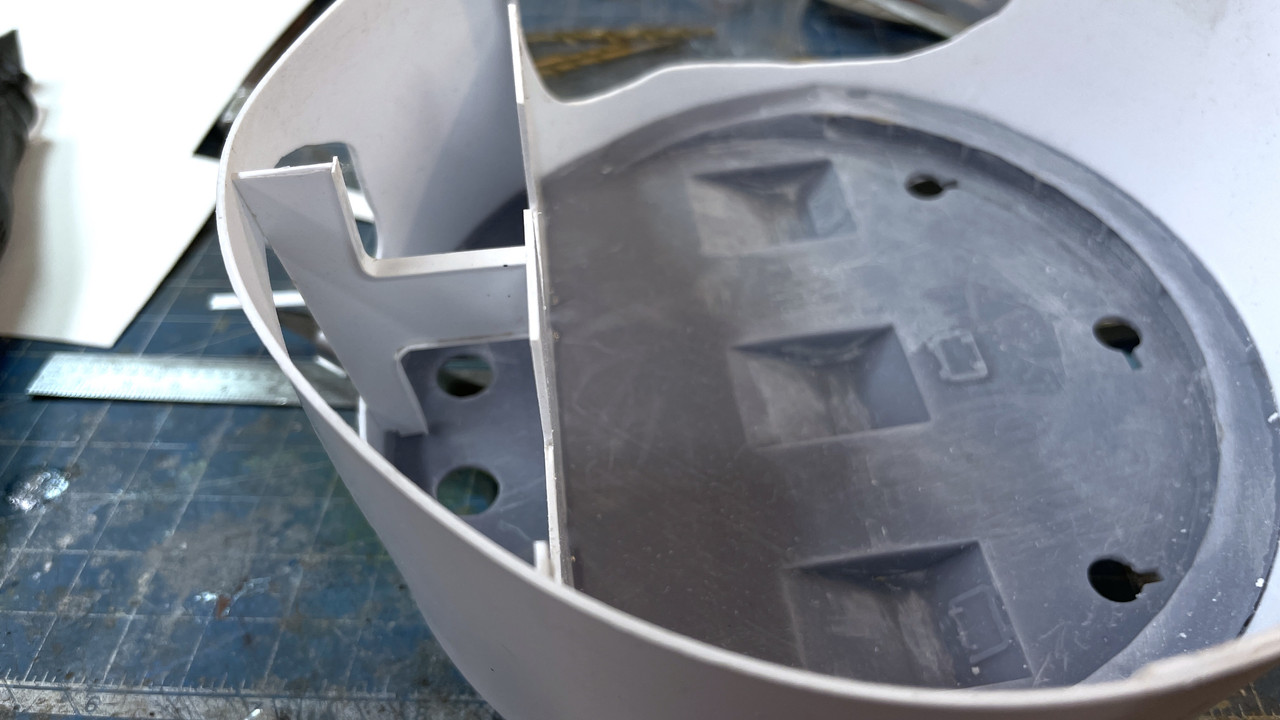
Now I had a decision to make. I couldn't glue this in if the training gear wasn't installed since I couldn't get the training gear in with this bulkhead in place. But I wanted the bulkheads to be all glued in before painting. I bit the bullet and prime painted the gear head, and installed it with thin CA. I then final glued the front bulkhead in place with solvent and CA as before. I then added some reinforcing blocks around that front butt joint. I didn't want it breaking loose. These are behind the wall and won't be visible through the cutaway. I'll just have do some fancy brush painting to do the gear head.
I put the webbing on the center buikhead so I had to put it on the transverse one. Finicky, but fun.
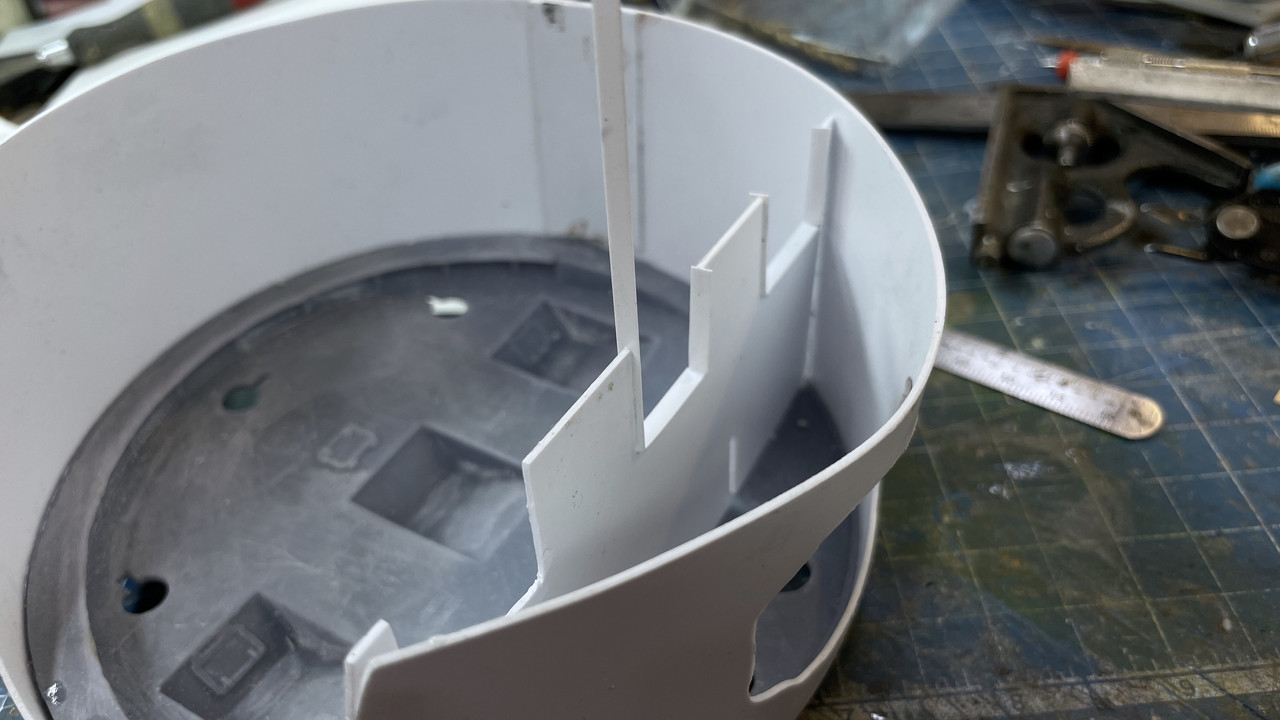
With everything glued in place, it's now ready for paint.
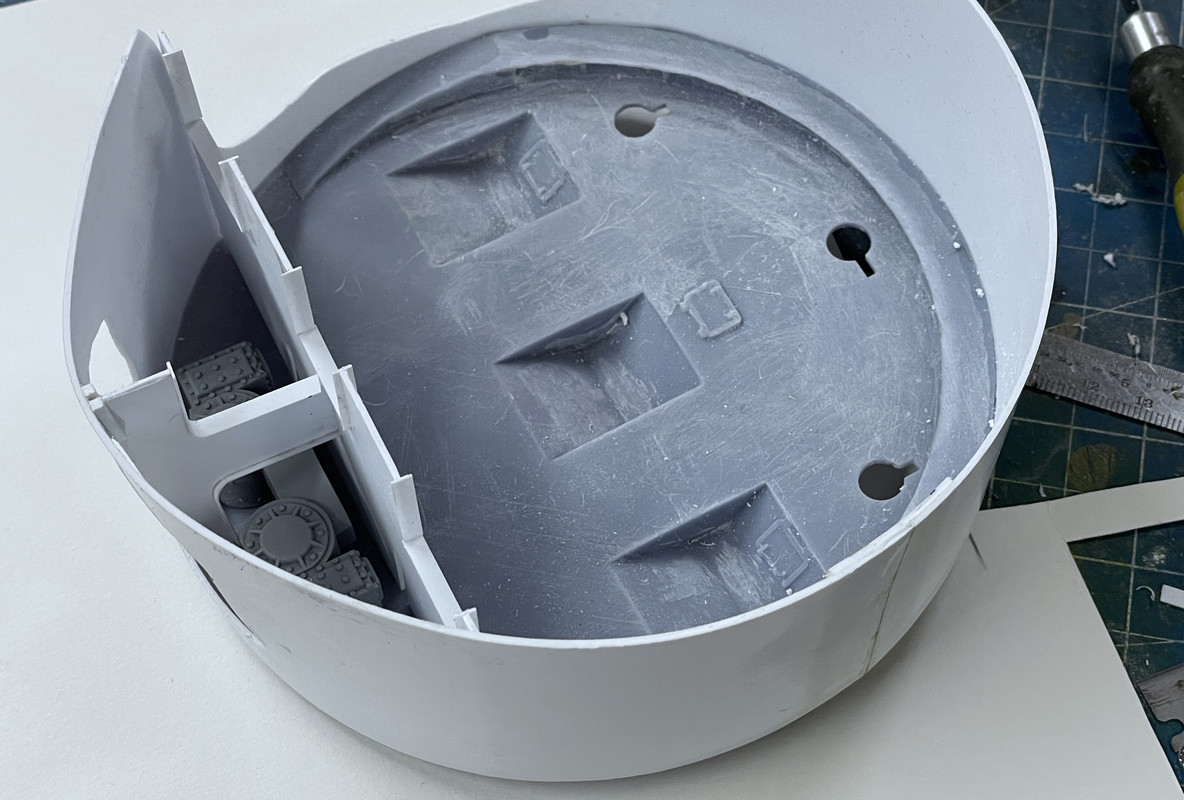
Here's the view through the cutaway.

I did one more print job.
I was trying to figure out how to support the model on the display base. I was going to machine a part out of brass, but then said... "Draw it and print it". It's going to be below the base underneath in the circuitry box. The leads for the LEDs will come out of the hollow CPVC tube below the base. The screw holes are just place holders since I don't know what hardware I'll be actually using.
The printed through hole is a couple of thousandths under 5/8" so the copper tube wouldn't get all the way through. i turned it into a ream by grinding a slice in the tube's edge and a cutting lip and by twisting it, let it open the hole up enough to pass it. It worked. And the plastic tube is a nice tight slip fit. This is the bottom that will be in the box.
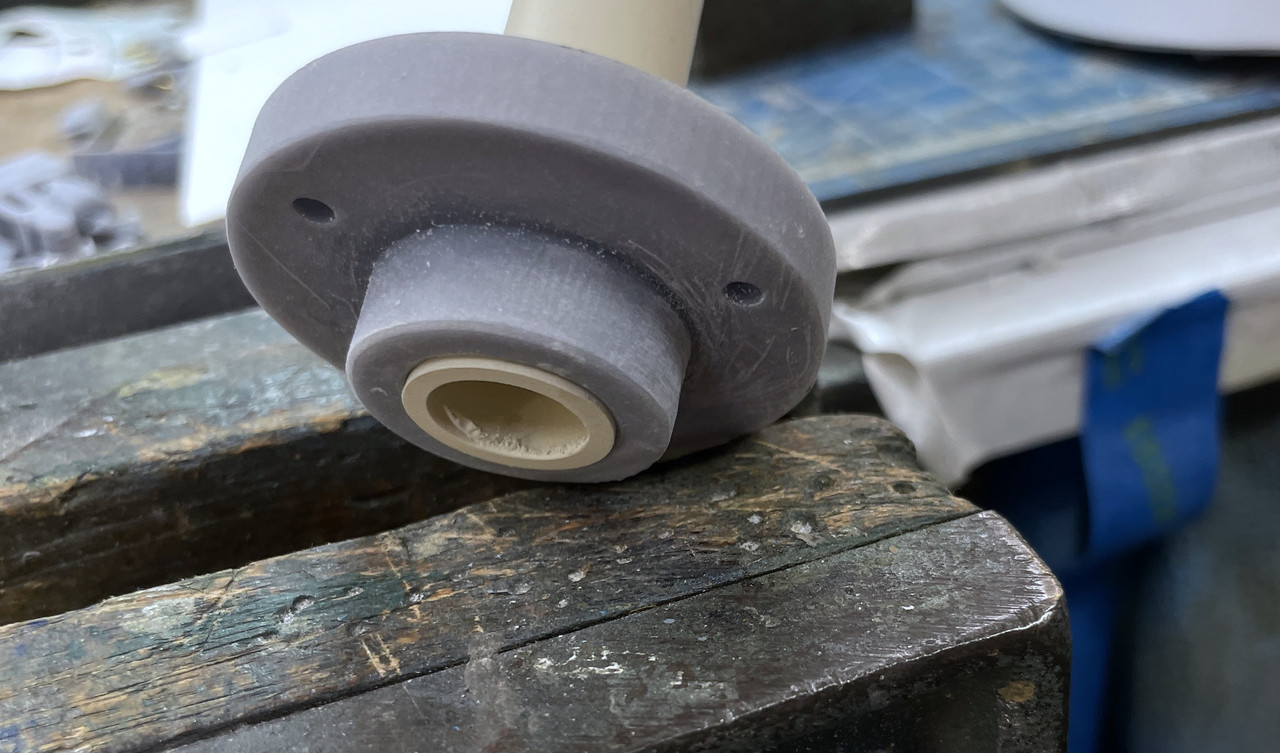
And this is the mounting surface that will go up against the base box surface. I notice a discontinuity on the one of the screw bosses. The radius didn't form a solid around that one. I hope it will work as it is.

I did a quick estimate of the center column height and cut it off with my big chop saw. I put the stack together just for fun. It does not penetrate the electric deck. It sits in a socket, but as I'm writing this I realize that I will need to find a way to get all the wiring from the this deck, the pan deck and the gun house through that tube and down to the base. There's a lot of bulkheads that aren't going to have cutaways or be transparent so it shouldn't be a problem. Just have to keep it in mind. It's why doing all this journaling actually helps me produce a better model.
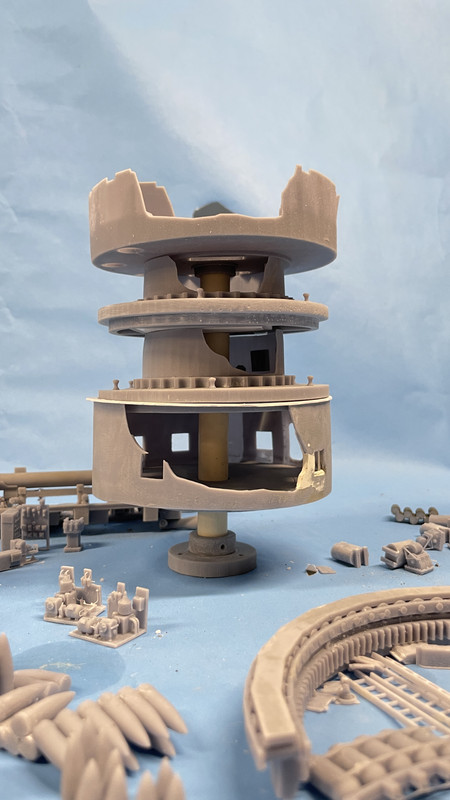
I don't actually know the wood thickness that my friend is going to use so the spacing below the powder flat is just an estimate. The actual boss diameter is .79" which is bigger than 3/4" and I don't know of a drill that size. I needed to give the walls some meat to support the tubing and the tube is 5/8". The boss is supporting the tube, not the base so the hole can be any size bigger that the boss.
Tomorrow I will tackle the electric deck. It too is going to have some scratch-built add-on small bulkheads.